Internal communications “iComm” enhancements
Townhall Meeting
This functionality requires the 5.3 Aurea Social and 5.3 Internal Communications solution (or later versions).
Over the years, several companies have found that one of the most compelling use cases for social was live events where leaders or experts posted and reacted to questions in the stream while a live audience viewed and interacted.
The default activity stream in Aurea Social is optimized around providing a rich viewing experience, and it is often placed on pages that have a lot of content.
Correspondingly, live events can place a much larger load on the platform than what it is typically sized to handle for steady-state usage. Because of this Skyvera has historically guided customers away from this use case or encouraged lots of testing and focusing on smaller-scale conversations.
The Townhall Meeting feature is designed to give companies an interface and backend that performs well with larger audiences as well as providing some specific tools to configure and run these sessions well.
A Townhall Meeting happens on a lightweight meeting page that can be configured by non-technical staff without need for SharePoint permissions.
The iComm Solution provides central management for defining and viewing these meetings, but community owners can also create these meetings independently for their community.
An existing community is used as the “home” for the stream and the content. This keeps the benefits of having the posts in the stream and a logical place to store content. The meeting administrator configures a townhall meeting page (detailed below) and publicize the link to that page.
When the meeting happens, users participate on a lightweight page and the meeting administrators and speakers have a separate meeting management page. If a user attempts to visit the community page while a townhall meeting is running, she is redirected to the lightweight page.
For an iComm administrator, creating or editings a meeting is done from the Townhall Meeting tab in the iComm admin page.

Townhall Meeting
Public community owners can create Townhall Meetings for their communities the Admin tab view the Manage Meetings link. This gives community owners the same create and edit options as are available in the iComm administration UI.

Manage Meetings link
Selecting the create a new meeting option presents a dialog box.
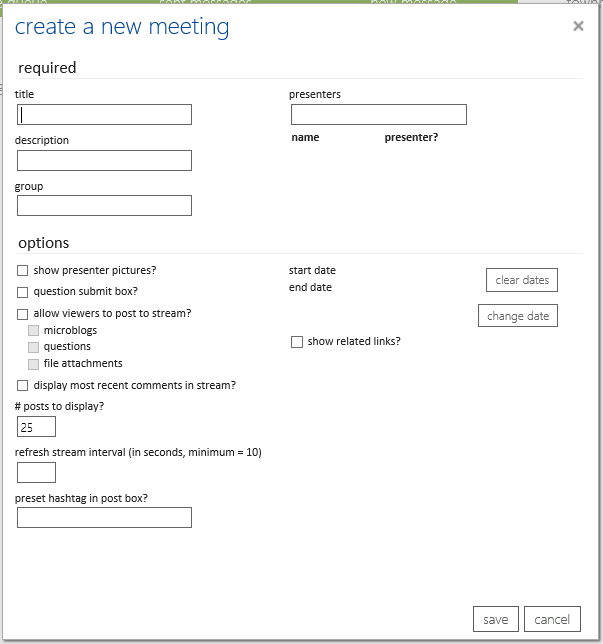
Creating a new meeting
The required section includes entering a title and description for the meeting as well as selecting a group (community or sphere) to which the meeting is tied. The conversation from this meeting is visible in this community or sphere after the meeting has ended.
The presenters section allows you to choose the people who has access to the presenter page.

Presenters section
The presenter checkbox indicates a person whose picture can be shown on the viewer page.
In the options section, the show presenter pictures choice causes thumbnail of each checked presenter in the required section to be displayed on the viewer page. This gives viewers a visual of the people who are the formal hosts of the event and gives them a way to see the profiles for the presenters.
The question submit box option creates a channel for viewers to send question privately to the presenters. You might want to enable this in a case where you either want to allow viewers the opportunity to ask a question without it appearing in the stream for everyone if you feel like this makes people more open to asking. You might also want to use this if you do not want meeting participants to post questions directly the stream – you may want the presenters to have the opportunity to review and maybe rephrase or consolidate questions before answering.
The allow viewers to post to stream section determines whether the meeting participants can initiate new posts in the stream. In some cases, you may want the presenters to be the only people creating the initial posts or questions. You can also control whether viewers can attach files (enabling this only makes sense if either microblogs or questions are enabled).
Display most recent comments in stream affects how posts appear in the stream. With this setting enabled, posts include most recent comments when a user views the stream. With this off, only text from the post itself displays and users have to click into the detailed view to see text from comments.
# posts to display controls the length of the stream. If you specify a refresh stream interval, the stream automatically updates on the viewer’s screen at that pace. Viewers can pause this behavior. The fastest you can set is 10 seconds. If you use this feature, it’s good to experiment with the pace of updating to see what works well for users and load on the system. You may want to start with something like a 30-second update frequency and adjust from there.
The preset hashtag option helps if you want a whole meeting to have the same hashtag in every post.
Start and end date and times are used for redirecting users who are visiting the community during the time of the meeting to send them to the lightweight townhall meeting page.
The related links section allows you to specify links that viewers may find helpful during the meeting.
For example, if the meeting is talking about a product release, you might provide links to a product collateral and documentation.
You can change the settings for a meeting at any time. If you change the settings during a meeting, users needs to reload the page to be able to see the results.
Below is an example of fully defined meeting.
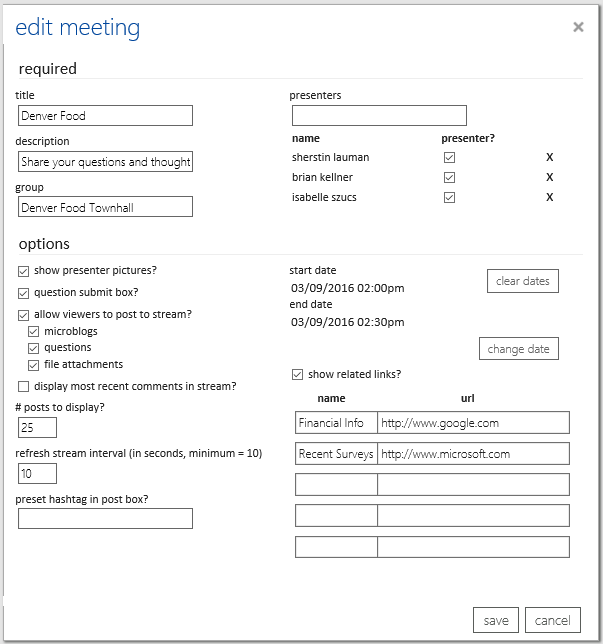
edit meeting
With these settings, the Viewer’s page looks like this.
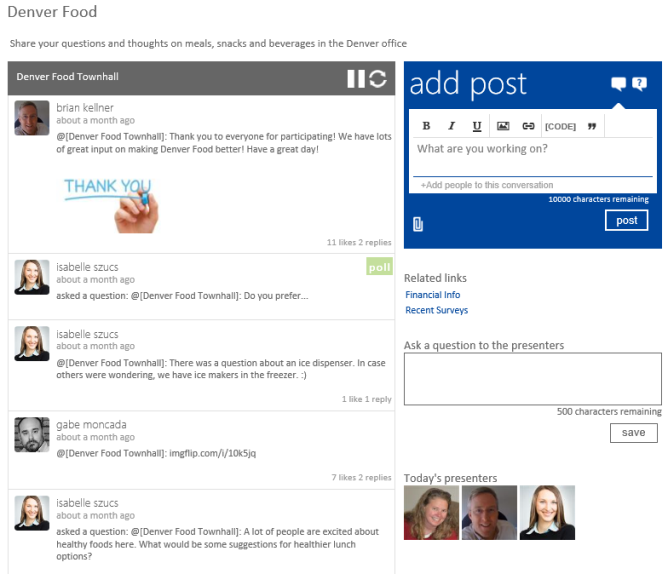
Viewer's page
The main stream is on the left side. Because viewers are allowed to post, there is a post box on the right. The related links, questions box, and presenter’s pictures settings are also turned on, so those sections show on the right as well.
When a viewer clicks on stream item (a poll in the example below), a pop up view of that item with all the text and comments is displayed.
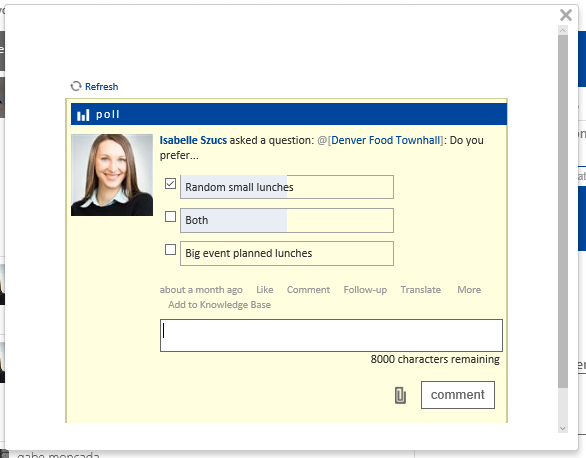
Stream item
Viewers who want to follow a particular thread of the conversation can keep this view open and just click refresh to see the latest updates.
The presenter page is similar to the viewers page.
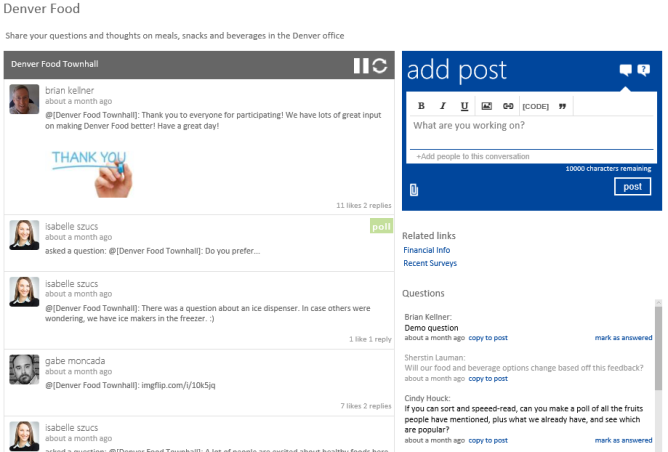
Presenter page
Presenters always have a post box available even if viewers do not. If the “questions box” is enabled for viewers, the presenters get a list of all the submitted questions on the right.
A link lets the presenter easily copy the question to the post box for editing (e.g. “Brian asks – demo question”) and posting to the whole meeting. The “mark as answered” link lets presenters keep track of questions which have been closed out.
From the presenter page, there is also a link to the “view post-event summary” page detailed below. Clicking this link prompts for the start and end time for your report.
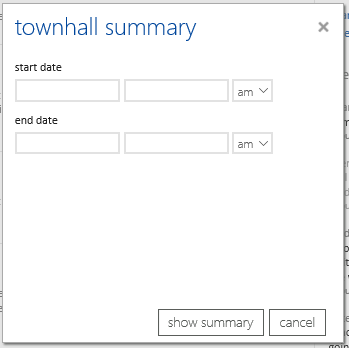
Enter dates to view townhall summary
The summary page provides reports on how the event transpired. By showing posts (microblogs and questions), replies (comments and answers), likes and meeting questions (if the question box is enabled) over time, it gives presenters an understanding of both the level of activity and how that flowed over the course of the meeting.
The shows the total people who viewed the meeting page during that time (total participants) as well giving access to file of all the participant ID numbers (this is really only helpful for use in custom reporting scenarios).
The “view transcript” link provides a page that shows the entire conversation during the meeting time for people who could not participate live.
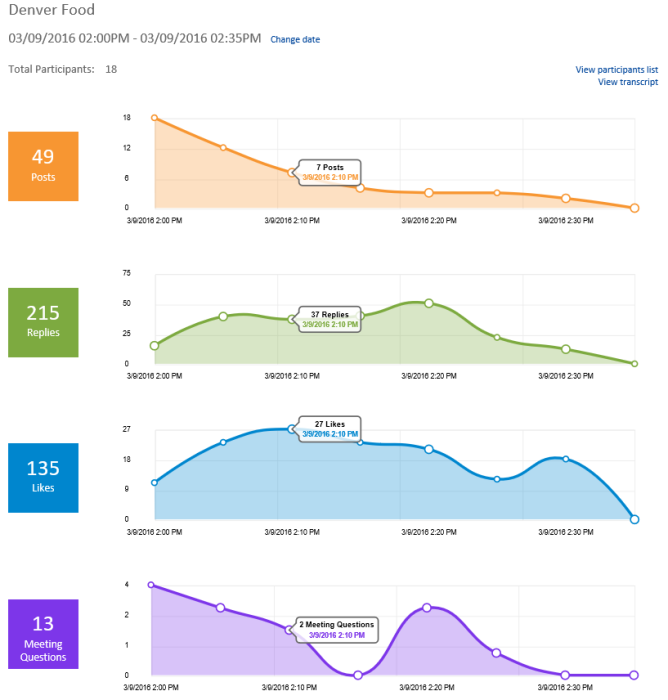
Summary view page
At the bottom of the summary page, the most active participants in a few categories are highlighted.

Most active participants
This can be helpful if you to reward certain behavior (e.g. give a prize to three people who replied the most).